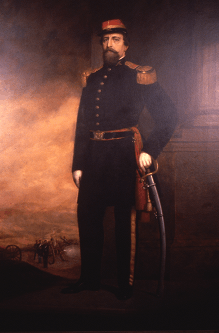James B. Walton
James Burdge Walton (1813–85) served for two decades in the famed New Orleans militia unit the Washington Artillery.[1] He was most prominent in the Confederate service in the American Civil War as commander of the Washington Artillery out of New Orleans and as Inspector-General of Field Artillery of the Confederate States, the highest position an artillery officer could achieve. He was a descendant of signer of the Declaration of Independence, George Walton.
James Burdge Walton | |
|---|---|
 | |
| Born | 1813 New Jersey |
| Died | 1885 New Orleans |
| Allegiance | United States of America Confederate States of America |
| Service/ | United States Army (Militia) Confederate States Army |
| Years of service | 1839–61 (USA) 1861–64 (CSA) |
| Rank | Colonel |
| Unit | Washington Artillery |
| Battles/wars | Mexican–American War American Civil War |
Early life
Born in New Jersey, Walton attended college in Louisiana and owned a New Orleans grocery store.
Military service
Mexican American War
Walton joined the Washington Artillery as an adjutant when the unit was formed in 1839. In the Mexican War, Walton commanded the 1st Louisiana Artillery as a Major and by 1857 he was Colonel Commanding of the battalion.[2]
Civil War
At the outbreak of the Civil War, Walton and four of five batteries went East to serve in Virginia. After fighting at the First Battle of Manassas, Walton and his command were assigned to James Longstreet's forces. These batteries served in the Peninsula Campaign, at Second Manassas, and Antietam. Walton commanded the batteries on Marye's Heights during the Battle of Fredericksburg and the Chancellorsville Campaign. He commanded the artillery reserve of the First Corps artillery and was offended when at Gettysburg a subordinate Colonel E. Porter Alexander was placed in charge of the artillery preparation for Pickett's Charge on July 3, 1863.
When the bulk of Longstreet's First Corps were sent to Georgia (United States), only a portion of the artillery was sent with it. Walton held several positions in southern Virginia during the absence of his guns. Walton worked to improve artillery formations and drills, it was during this time that he rose to the rank of Colonel after an act was passed through the congress of the Confederacy, making him the highest ranking artillery officer in the Confederacy. A prominent accomplishment of his was the design for the Hanging Tigers Head used as a badge by the Washington Artillery. He resigned on July 18, 1864 and returned to his business as a merchant.[3]
Family life
Walton's son, James B. Jr., was a student at Virginia Military Institute class of 1865 who resigned to join the Confederacy in 1861.[2]
References
- "Louisiana National Guard History and Mission". Archived from the original on July 28, 2011. Retrieved January 6, 2008.
- Antietam on the Web Archived September 28, 2007, at the Wayback Machine
- Sifakis, Who Was Who in the Confederacy